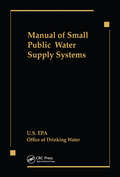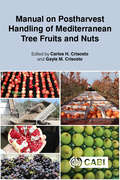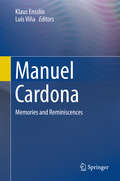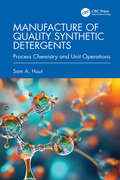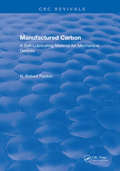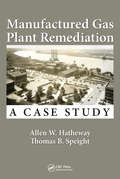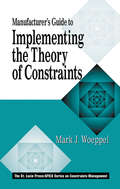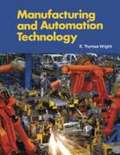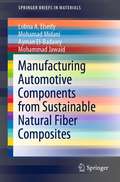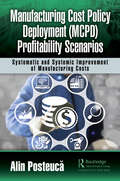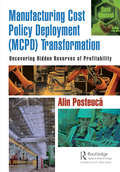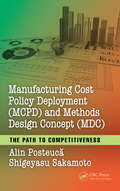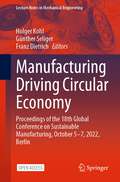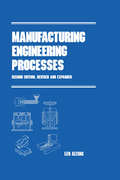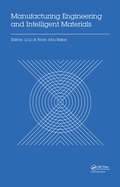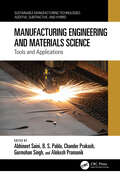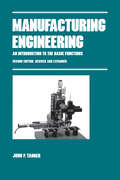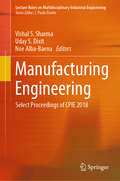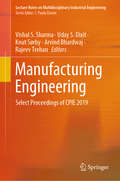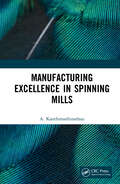- Table View
- List View
Manual of Small Public Water Supply Systems
by Us EpaManual of Small Public Water Supply Systems presents current concepts and practices affecting water treatment, financing, management, community involvement in water supply, institutional support, and development of human resources for improved operations and management of water supplies. Information on ground water, surface water, and SDWA requirements is also provided. In short, everything you need to run your small water treatment facility can be found in this book. Material is presented in a thorough, easy-to-read format and a complete bibiliography is included. Fully illustrated, Manual of Small Public Water Supply Systems will soon be dog-eared with use.
Manual of Sports Photography
by E. S. Dempsey Cristiano PugnoThe Manual of Sports Photography is a handbook about taking excellent sports photos. Cristiano Pugno is a professional photographer who has made a short guide to getting the best action shots, whether it be in soccer (football), running, gymnastics, or water sports. Keep this little manual with you when you are shooting athletic events; it will help you take front-page photos.
Manual on Postharvest Handling of Mediterranean Tree Fruits and Nuts
by George Athanasios Manganaris Sebastián Sáa Silva Cristina Besada Reinaldo Campos-Vargas Giancarlo Colelli Joseph H Connell Gemma Echeverria Louise Ferguson Margarita López Corrales Amnon Lichter Alejandra Salvador Manuel Joaquín Serradilla Sánchez Daniel Valero GarridoPostharvest is an important element of getting fresh, high-quality fruit to the consumer and technological advances continue to outpace infrastructure. This book provides valuable, up-to-date information on postharvest handling of seven fruit and nut crops: almond, fig, peach, persimmon, pistachio, pomegranate and table grape. These crops are of particular importance in the Mediterranean region, but also to those countries that export and import these crops, where intensive economic resources are dedicated to developing information to understand and solve their postharvest problems. Written by a team of internationally-recognized postharvest experts, this manual collates and verifies essential, but often difficult to access, information on these important crops, that is pertinent to the world's agricultural economy and affects agricultural communities. The book: Covers relevant postharvest topics for each crop across harvesting, packing, shipping and retail postharvest phases. Has an emphasis on knowledge useful to solve current worldwide industry problems. Includes practical recommendations. Makes available for the first time in English information previously published in other languages. Includes up-to-date references and high-quality photos that make it an excellent resource for postharvest educators and students. This is a must-have manual for growers and commodity handlers, cold storage managers, transportation personnel, produce managers and retail handlers, researchers, or anyone in the food chain that packs, transports, stores and sells these fruits and nuts.
Manuale di istruzioni per Echo Dot di terza generazione: Il più completo manuale di istruzioni di Amazon Echo Dot di terza generazione con Alexa, per principianti
by Paul O. GartenOttieni il meglio dal tuo AMAZON ECHO DOT. Scopri come impostare le funzioni e iniziare ad usarlo in meno di 1 ora. Questo libro tratta essenzialmente tutti i dettagli di IMPOSTAZIONE, PERSONALIZZAZIONE e GESTIONE del dispositivo smart di terza generazione Echo Dot. All'interno, imparerai come: Configurare alcuni servizi musicali e impostare musica multi-stanza con Alexa, come creare i profili Utente e i profili per il tuo Guppo Famiglia. Potrai collegare il tuo Echo Dot a Internet e accoppiare un altoparlante Bluetooth o il tuo stereo di casa. Potrai modificare la parola che attiva Alexa e cambiarla con Echo, Computer o Amazon. Potrai impostare il tuo Echo Dot in stanze diverse, impostare dei promemoria, le sveglie, la data e l'ora, effettuare chiamate e inviare SMS con Alexa. Imparerai a creare una routine e con Alexa Blueprints potrai anche creare le tue Skill personali. Con Alexa potrai anche gestire la tua Fire TV, leggere i tuoi Kindle o ascoltare i tuoi audiolibri. Potrai anche collegare il tuo indirizzo email e il tuo calendario. Con Alexa puoi fare acquisti su Amazon in tutta sicurezza. Potrai imparare come eliminare le registrazioni vocali dalla cronologia di Alexa. Potrai rendere la tua casa smart e creare un Gruppo. Anche i protocolli IFTTT possono essere integrati nelle funzioni di Alexa. Ad Alexa puoi chiedere informazioni sui luoghi vicino ai quali ti trovi: ristoranti e attivita' commerciali, ad esempio. Con Alexa puoi anche giocare. Configura Alexa perche' giochi con i bambini. Infine, troverai anche una sezione dedicata alla risoluzione dei problemi che potresti avere con il tuo Echo Dot e con Alexa. Puoi anche cliccare su "Guarda dentro" per saperne di piu'.
Manuel Cardona
by Klaus Ensslin Luis ViñaThis book pays tribute to an extraordinary researcher and personality, Manuel Cardona. He had significant influence in the development of science and inside the scientific community. The book consists of contributions by former collaborators and students of Prof. Manuel Cardona. The short contributions deal with personal encounters with Manuel Cardona describing his extraordinary personality. This includes descriptions of scientific discussions, Manuel Cardona's involvement in social justice and his enormous knowledge about human culture, languages and history.
Manuel de photographie sportive
by Cristiano Pugno SbCe manuel de photographie sportive offre les conseils de base pour réaliser de bons reportages sportifs. Les grandes lignes générales sont exposées et également les informations spécifiques pour quelques sports très populaires (football, gymnastique etc.) L'auteur aborde également les questions de l'editing.
Manufacture of Quality Synthetic Detergents: Process Chemistry and Unit Operations
by Sam A. HoutThis book provides a thorough exploration of the step- by- step manufacturing processes utilized in the global production of synthetic detergents. Drawing from real- world manufacturing experience at various detergent plants both domestically and internationally, the text presents valuable insights into the industry. Manufacture of Quality Synthetic Detergents: Process Chemistry and Unit Operations discusses the essential aspects of detergent processing techniques, quality by design, risk assessment and management, and operational requirements. The book also covers the regulations and guidelines set forth by reputable organizations such as the ACS, AIChE, ICE, and AOCS. In addition, it provides a detailed explanation of quality methodologies for granular detergent size and agglomeration, as well as offers techniques for systematic process optimization and good manufacturing practice. The importance of paying attention to detail in process development and validation is emphasized, with real- world examples showcasing various facets of synthetic detergent manufacturing. This comprehensive guide serves as a valuable reference for chemists, chemical engineers, manufacturing professionals, and engineers working in granular and liquids sciences, and manufacturing. It is an indispensable resource for those seeking to enhance their knowledge and skills in the field.
Manufactured Carbon: A Self-Lubricating Material for Mechanical Devices
by R.R. PaxtonThis book discusses manufactured carbon for the purposes of being a self-lubricating material for mechanical devices. Topics include; properties and graphite crystals, properties of manufactured carbon, the manufacture of carbon articles, machining carbon, carbon in mechanical seals, carbon in bearings, rotary pumps and motors, metering devices, and piston rings and cylinder liners.
Manufactured Gas Plant Remediation: A Case Study
by Allen W. Hatheway Thomas B. SpeightThe assessment, remediation, and redevelopment of manufactured gas plant (MGP) sites pose a significant technical and financial challenge to successor property owners, including municipalities and other public entities undertaking brownfields revitalization, and to their consulting environmental engineers. Due to the toxicity of many coal tar constituents, sites contaminated as a result of gasworks operations pose a significant threat to public health. This book will discuss the history of the manufactured gas industry in Massachusetts (the largest in the US), as well as the toxicity of gasworks waste products, technical challenges in the cleanup process, and the process for site cleanups.
Manufacturer's Guide to Implementing the Theory of Constraints (The CRC Press Series on Constraints Management)
by Mark WoeppelEveryone in business today has heard of the Theory of Constraints (TOC), developed by Eli Goldratt in his groundbreaking book The Goal. However, very few people know how to implement it in a manufacturing organization. The Manufacturer's Guide to Implementing the Theory of Constraints answers all your questions and more.Written by Mark Woep
Manufacturing And Automation Technology
by R. Thomas WrightProvides thorough coverage of manufacturing as it relates to the Standards for Technological Literacy.
Manufacturing Automation
by Yusuf AltintasMetal Cutting is one of the most widely used methods of producing the final shape of manufactured products. The technology involved in metal cutting operations has advanced considerably in recent years, along with developments in materials, computers, and sensors. This book treats the scientific principles of metal cutting and their practical application to solving problems encountered in manufacturing. The subjects of mathematics, physics, computers, and instrumentation are discussed as integration tools in analyzing or designing machine tools and manufacturing processes. The book begins with the fundamentals of metal cutting mechanics. The basic principles of vibration and experimental modal analysis are applied to solving problems on the shop floor. A special feature is the in-depth coverage of chatter vibrations, a problem experienced daily by practicing manufacturing engineers. The essential topics of programming, design, and automation of computer numerically controlled (CNC) machine tools, numerically controlled (NC) programming, and computer-aided design/computer-aided manufacturing (CAD/CAM) technology are discussed. The text also covers the selection of drive actuators, feedback sensors, the modeling and control of feed drives, the design of real-time trajectory generation and interpolation algorithms, and CNC-oriented error analysis in detail. Each chapter includes examples drawn from industry, design projects, and homework problems. Advanced undergraduate arid graduate students, and practicing engineers as well, will find in this book a clear and thorough way to learn the engineering principles of metal cutting mechanics, machine tool vibrations, CNC system design, sensor-assisted machining, and CAD/CAM technology. Book jacket.
Manufacturing Automotive Components from Sustainable Natural Fiber Composites (SpringerBriefs in Materials)
by Mohammad Jawaid Mohamad Midani Lobna A. Elseify Ayman El-BadawyThis book focuses on the use of natural fiber composites (NFCs) in the automotive industry. The new race in the automotive industry is no longer speed, but rather low weight and sustainable. Major automakers and component suppliers are now shifting to natural fiber reinforcements for their composite components as a sustainable and lightweight alternative to conventional, synthetic reinforcements. The main object of this book is to bridge the gap between academic literature and actual industry practices, and to provide a comprehensive and integrated review on the use of NFC in the automotive industry from composite fabrication to recycling. The book focuses on the major areas of interest to academic researchers, such as the history of NFC in the automotive industry, specific types of materials used, material qualification programs, major technical challenges facing NFC, major processing techniques and parameters, analysis of major NFC parts used and their performance requirements, sustainability assessments including life cycle assessment and carbon footprint, and future trends.
Manufacturing Control of Textile Materials: Operational Computerized Non-contact Methods (Studies in Systems, Decision and Control #460)
by Artur Zaporozhets Valerii Zdorenko Nataliia Zashchepkina Sergiy Barylko Serhii Lisovets Ihor KivaThis book examines issues of improving the efficiency of the control technological parameters of textile materials through with computerized systems with the application of non-contact methods as only they allow to react quickly to changes of technological parameters during production. The original models, algorithms, software and hardware of the developed system for the control technological parameters of textile materials are presented. Also, the book presents new methods for measuring the technological parameters of textile materials, which do not need require taking into account the constant readjustment of the system to controlled samples of materials with different structure and porosity. The developed model of the computerized system allows contactless control of basis weight and porosity of fabrics in the course of their production. This book contains six chapters, for researchers, engineers, as well as lecturers and postgraduates of higher education institutions dealing with ultrasonic control engineering equipment.
Manufacturing Cost Policy Deployment (MCPD) Profitability Scenarios: Systematic and Systemic Improvement of Manufacturing Costs
by Alin PosteucaThis book shows how to consistently obtain annual and multiannual manufacturing target profit regardless of the evolution of sales volumes, increasing or decreasing, using the Manufacturing Cost Policy Deployment (MCPD) system. Managers and practitioners within the manufacturing companies will discover a practical approach within the MCPD system that will help them develop and support their long-term, medium-term, and short-term profitability and productivity strategy. The book presents both the basic concepts of MCPD and the key elements of transforming manufacturing companies through MCPD system, as well as supporting the consistent growth of external and internal profit by directing all systematic and systemic improvements based on meeting the annual and multiannual Manufacturing Cost Improvement (MCI) targets and means for each Product-Family Cost (PFC). <P><P>This book is unique because it presents two types of systematic and systemic improvement projects for MCI that have been applied over the years in various multinational manufacturing companies operating in highly competitive markets, in order to address the consistent reduction of unit manufacturing costs by improving the Cost of Losses and Waste (CLW). <P><P>Readers will discover the practical approach of MCI based on a structured approach to MCPD system beyond the traditional approach to manufacturing improvements based mainly on improved time and quality. Therefore, from the perspective of the MCPD system, the multiannual manufacturing target profits are met while the annual and multiannual manufacturing target costs are a predetermined stake and not a result of the improvements already made.
Manufacturing Cost Policy Deployment (MCPD) Transformation: Uncovering Hidden Reserves of Profitability
by Alin PosteucaAchieving a long-term acceptable level of manufacturing profitability through productivity requires the total commitment of management teams and all staff in any manufacturing company and beyond. Awareness and continuous improvement of manufacturing costs behind losses and waste is the core goal of the Manufacturing Cost Policy Deployment (MCPD). Achieving this goal will continually uncover the hidden reserves of profitability through a harmonious transformation of the manufacturing flow, coordinated by the continuous need to improve manufacturing costs. Setting annual targets and means for manufacturing costs improvement (more exactly for costs of losses and waste, and the exact fulfillment of these) requires mobilization of all people in the company to carry out systematic improvement activities (kaizen) and systemic improvement actions (kaikaku) of the processes of each product family cost. The MCPD system was born out of careful observation of the challenges, principles, and phenomena of manufacturing companies and the profound discussions with the people in these companies at all levels. Manufacturing Cost Policy Deployment (MCPD) Transformation: Uncovering Hidden Reserves of Profitability is organized in three sections. The first section presents the concept and the need for an MCPD system from a managerial perspective. In the second section, the transformation of manufacturing companies through the MCPD system is presented, more precisely the details of the initial steps of the implementation of the MCPD, the three phases and the seven steps of the MCPD, and the elements necessary for a constant and consistent application of the MCPD. In the last section, there are two examples of the MCPD implementation in two different types of industries, namely, manufacturing and assembly industry and process industry, and two case studies for the improvement of manufacturing costs for each (cost of equipment setup loss, using kaizenshiro; replacement of bottleneck equipment and associated costs of losses, using kaikaku; cost of quality losses with improving operators’ skills to sustain quality, using kaizen; and cost problem solving with the consumption of lubricants for one of the equipment, using A3).
Manufacturing Cost Policy Deployment (MCPD) and Methods Design Concept (MDC): The Path to Competitiveness
by Shigeyasu Sakamoto Alin PosteucaProviding a reasonable level of profitability through productivity is - and will remain - one of the fundamental tasks of the management teams of any production company. Manufacturing Cost Policy Deployment (MCPD) and Methods Design Concept (MDC): The Path to Competitiveness contains two new methodologies to improving the productivity and profitability of production systems that continuously increase competitiveness: Manufacturing Cost Policy Deployment (MCPD) and Methods Design Concept (MDC). Both MCPD and MDC are the result of long-time synthesis and distillation, being implemented successfully, totally or partially, in many companies. The MCPD system, developed by Alin Posteucă, is a manufacturing cost policy aimed at continuous cost improvement through a systemic and systematic approach. The MCPD is a methodology that improves the production flow driven by the need for Manufacturing Cost Improvement (MCI) for both existing and future products through setting targets and means to continuously improve production process productivity for each product family cost. The MDC, developed by Shigeyasu Sakamoto, design the effective manufacturing methods using a tool of engineering steps identifying ideas for increasing productivity called KAIZENSHIRO (improvable value as a target). The MDC results on production methods lead to effectiveness of work measurement for performance (P) and to knowledge and improvement of production control and planning as utilization (U), in order to achieve labor target costs. The combination of MCPD and MDC methodologies can provide a unique approach for the managers who are seeking new ways for increasing productivity and profitability to increase the competitive level of their manufacturing company.
Manufacturing Driving Circular Economy: Proceedings of the 18th Global Conference on Sustainable Manufacturing, October 5-7, 2022, Berlin (Lecture Notes in Mechanical Engineering)
by Holger Kohl Günther Seliger Franz DietrichThis is an open access book. It gathers the proceedings of the 18th Global Conference on Sustainable Manufacturing, held on October 5-7, 2022, as a hybrid event, in/from Berlin, Germany. With a focus on manufacturing advances and practices driving the circular economy, the chapters selected for this book report on sustainable manufacturing technologies for the mobility, energy and construction sector, and for machines and equipments, covering applications of artificial intelligence and industry 4.0. Moreover, they discuss energy-efficient process, waste reuse, and CO2 neutral production, giving a special emphasis to developing sustainable manufacturing in emerging countries. This book offers extensive and timely information for both researchers and professionals in the field of manufacturing and business development.
Manufacturing Engineering Processes, Second Edition
by Leo AltingResponding to the need for an integrated approach in manufacturing engineering oriented toward practical problem solving, this updated second edition describes a process morphology based on fundamental elements that can be applied to all manufacturing methods - providing a framework for classifying processes into major families with a common theoretical foundation. This work presents time-saving summaries of the various processing methods in data sheet form - permitting quick surveys for the production of specific components.;Delineating the actual level of computer applications in manufacturing, this work: creates the basis for synthesizing process development, tool and die design, and the design of production machinery; details the product life-cycle approach in manufacturing, emphasizing environmental, occupational health and resource impact consequences; introduces process planning and scheduling as an important part of industrial manufacturing; contains a completely revised and expanded section on ceramics and composites; furnishes new information on welding arc formation and maintenance; addresses the issue of industrial safety; and discusses progress in non-conventional processes such as laser processing, layer manufacturing, electrical discharge, electron beam, abrasive jet, ultrasonic and eltrochemical machining.;Revealing how manufacturing methods are adapted in industry practices, this work is intended for use by students of manufacturing engineering, industrial engineering and engineering design; and also for use as a self-study guide by manufacturing, mechanical, materials, industrial and design engineers.
Manufacturing Engineering and Intelligent Materials: Proceedings of the 2015 International Conference on Manufacturing Engineering and Intelligent Materials (ICMEIM 2015), Guangzhou, China, 30-31 January 2015
by Li Lu Nooh Abu BakarThis volume is a collection of papers from experts and scholars presented at the 2015 International Conference on Manufacturing Engineering and Intelligent Materials (ICMEIM 2015), Guangzhou, January 30-31, 2015. It serves to discuss and share the latest new research results and developments on the topics manufacturing system and control engin
Manufacturing Engineering and Materials Science: Tools and Applications (Sustainable Manufacturing Technologies)
by Chander Prakash B. S. Pabla Alokesh Pramanik Abhineet Saini Gurmohan SinghThis book, which is part of a two-volume handbook set, gives a comprehensive description of recent developments in materials science and manufacturing technology, aiming primarily at its applications in biomedical science, advanced engineering materials, conventional/non-conventional manufacturing techniques, sustainable engineering design, and related domains. Manufacturing Engineering and Materials Science: Tools and Applications provides state-of-the-art research conducted in the fields of technological advancements in surface engineering, tribology, additive manufacturing, precision manufacturing, electromechanical systems, and computer-assisted design and manufacturing. The book captures emerging areas of materials science and advanced manufacturing engineering and presents the most recent trends in research for emerging researchers, field engineers, and academic professionals.
Manufacturing Engineering: AN INTRODUCTION TO THE BASIC FUNCTIONS, SECOND EDITION, REVISED AND EXPANDED (Manufacturing Engineering And Materials Processing Ser. #36)
by John P. TannerRevised and updated introduction, useful as a reference source for engineers and managers or as a text for upper-level undergraduate and graduate courses in technical colleges and universities. Includes end-of-chapter questions (an answer book is provided for teachers). Annotation copyright Book New
Manufacturing Engineering: Select Proceedings of CPIE 2018 (Lecture Notes on Multidisciplinary Industrial Engineering)
by Uday S. Dixit Vishal S. Sharma Noe Alba-BaenaThis book presents selected proceedings of the International Conference on Production and Industrial Engineering (CPIE) 2018. Focusing on recent developments in the field of production and manufacturing engineering, it provides solutions to wide-ranging contemporary problems in manufacturing engineering and other allied areas using analytical models and the latest numerical approaches. The topics covered in this book include conventional and non conventional machining, casting, welding, materials and processing. As such it is useful to academics, researchers and practitioners working in the field of manufacturing and production engineering.
Manufacturing Engineering: Select Proceedings of CPIE 2019 (Lecture Notes on Multidisciplinary Industrial Engineering)
by Uday S. Dixit Vishal S. Sharma Knut Sørby Arvind Bhardwaj Rajeev TrehanThis volume comprises select peer-reviewed contributions from the International Conference on Production and Industrial Engineering (CPIE) 2019. The contents focus on latest research in production and manufacturing engineering including case studies with analytical models and latest numerical approaches. The topics covered include micro, nano, and non-conventional machining, additive manufacturing, casting and forming, joining processes, vibrations and acoustics, materials and processing, product design and development, industrial automation, CAD/CAM and robotics, and sustainability in manufacturing. The book can be useful for students, researchers, and professionals working in manufacturing and production engineering, and other allied fields.
Manufacturing Excellence in Spinning Mills
by A. KanthimathinathanManufacturing towards Excellence in spinning mills aims to help the relevant organization to cut costs, improve throughput, effective utilization of resources and to safeguard the interests of stakeholders. Major aspects discussed includes quality assurance, production management, maintenance management of modern machinery and laboratory equipment towards achieving manufacturing excellence with benchmarking and industry norms. Relevant case studies are provided with dedicated chapters on training and development of employees, energy management and customer focus. Explains industry norms to benchmark any spinning mill against the manufacturing performance parameters. Includes Failure Mode and Effect Analysis and Total Productive Maintenance aspects. Explores training and development standards in spinning mills. Discusses energy management and customer focus through effective techniques. Reviews SPDM, PDM Tools, Contamination index, Spin plan, Customer Satisfaction Index, Co-Creation, and HPT This book is aimed at professionals and researchers in textile engineering and management.
